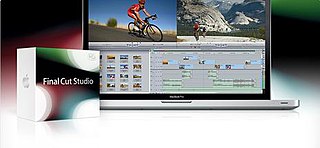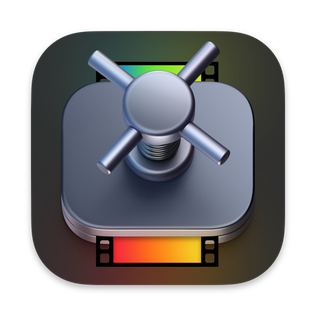
DivX is a brand of video codec products developed by DivX, LLC. There are three DivX codecs: the original MPEG-4 Part 2 DivX codec, the H.264/MPEG-4 AVC DivX Plus HD codec and the High Efficiency Video Coding DivX HEVC Ultra HD codec. The most recent version of the codec itself is version 6.9.2, which is several years old. New version numbers on the packages now reflect updates to the media player, converter, etc.

DVD-Audio is a digital format for delivering high-fidelity audio content on a DVD. DVD-Audio uses most of the storage on the disc for high-quality audio and is not intended to be a video delivery format.

iMovie is a free video editing application made by Apple for the Mac, the iPhone, and the iPad. It includes a range of video effects and tools like color correction and image stabilization, but is designed to be accessible to users with little or no video editing experience. iMovie's professional equivalent is Apple's Final Cut Pro X.

iLife is a discontinued software suite for macOS and iOS developed by Apple Inc. It consists of various programs for media creation, organization, editing and publishing. At various times, it included: iTunes, iMovie, iPhoto, iDVD, iWeb, and GarageBand. Only iMovie and GarageBand remain and are now freely available on Apple's Mac App Store. iDVD and iWeb have been discontinued while iTunes and iPhoto have been succeeded by Music and Photos respectively.

Final Cut Pro is a professional non-linear video editing application initially developed by Macromedia, and, since 1998, by Apple as part of their pro apps collection. Final Cut Pro allows users to import, edit, and process video footage, and output it to a wide variety of formats.

Motion is a software application produced by Apple Inc. for their macOS operating system. It is used to create and edit motion graphics, titling for video production and film production, and 2D and 3D compositing for visual effects.

Adobe Premiere Pro is a timeline-based and non-linear video editing software application (NLE) developed by Adobe Inc. and published as part of the Adobe Creative Cloud licensing program. First launched in 2003, Adobe Premiere Pro is a successor of Adobe Premiere. It is geared towards professional video editing, while its sibling, Adobe Premiere Elements, targets the consumer market.

Vegas Pro is a video editing software package for non-linear editing (NLE). The first release of Vegas Beta was on June 11, 1999. The software runs on Windows operating systems.
Final Cut Express was a video editing software suite created by Apple Inc. It was the consumer version of Final Cut Pro and was designed for advanced editing of digital video as well as high-definition video, which was used by many amateur and professional videographers. Final Cut Express was considered a step above iMovie in terms of capabilities, but a step underneath Final Cut Pro and its suite of applications. As of June 21, 2011, Final Cut Express was discontinued in favor of Final Cut Pro X.

Final Cut Studio is a discontinued suite of professional video production and post-production made by Apple for the Mac. The suite competed with Avid Media Composer for the high-end movie production market. It first went on sale in 2005.
LiveType was a computer program developed by Apple Inc. to create animated title sequences for video projects. It was discontinued with the release of Final Cut Pro X, Motion 5, and Compressor 4.

Compressor is a video and audio media compression and encoding application for use with Final Cut Studio and Logic Studio on macOS. It can be used with Qmaster for clustering, or configured as a server to work on the jobs submitted by other computers on the network.
AVCHD is a file-based format for the digital recording and playback of high-definition video. It is H.264 and Dolby AC-3 packaged into the MPEG transport stream, with a set of constraints designed around the camcorders.
Pirated movie release types are the different types of pirated movies and television series that end up on the Internet. They vary wildly in rarity and quality due to the different sources and methods used for acquiring the video content, in addition to encoding formats. Pirated movie releases may be derived from cams, which have distinctly low quality; screener and workprint discs or digital distribution copies (DDC), telecine copies from analog reels, video on demand (VOD) or TV recordings, and DVD and Blu-ray rips. They are seen in P2P networks, pirated websites and video sharing websites such as YouTube and Dailymotion.

HD DVD is an obsolete high-density optical disc format for storing data and playback of high-definition video. Supported principally by Toshiba, HD DVD was envisioned to be the successor to the standard DVD format.

Logic Studio is a discontinued professional music production suite by Apple Inc. The first version of Logic Studio was unveiled on September 12, 2007. It claims to be the largest collection of modeled instruments, sampler instruments, effect plug-ins, and audio loops ever put in a single application.
.m2ts is a filename extension used for the Blu-ray disc Audio-Video (BDAV) MPEG-2 Transport Stream (M2TS) container file format. It is used for multiplexing audio, video and other streams. It is based on the MPEG-2 transport stream container. This container format is commonly used for high definition video on Blu-ray Disc and AVCHD.

DVD-Video is a consumer video format used to store digital video on DVD discs. DVD-Video was the dominant consumer home video format in Asia, North America, Europe, and Australia in the 2000s until it was supplanted by the high-definition Blu-ray Disc. Discs using the DVD-Video specification require a DVD drive and an MPEG-2 decoder. Commercial DVD movies are encoded using a combination MPEG-2 compressed video and audio of varying formats. Typically, the data rate for DVD movies ranges from 3 to 9.5 Mbit/s, and the bit rate is usually adaptive. DVD-Video was first available in Japan on November 1, 1996, followed by a release on March 24, 1997 in the United States—to line up with the 69th Academy Awards that same day.

CineAsset is a complete mastering software suite by Doremi Labs that can create and playback encrypted and unencrypted DCI compliant packages from virtually any source. CineAsset includes a separate "Editor" application for generating Digital Cinema Packages (DCPs). CineAsset Pro adds the ability to generate encrypted DCPs and Key Delivery Messages (KDMs) for any encrypted content in the database.
Apple ProRes is a high quality, "visually lossless" lossy video compression format developed by Apple Inc. for use in post-production that supports video resolution up to 8K. It is the successor of the Apple Intermediate Codec and was introduced in 2007 with Final Cut Studio 2. Much like the H.26x and MPEG standards, the ProRes family of codecs use compression algorithms based on the discrete cosine transform (DCT). ProRes is widely used as a final format delivery method for HD broadcast files in commercials, features, Blu-ray and streaming.













